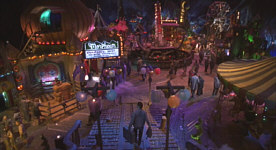 Well, I suppose it sounded like a good idea at the time. If nothing else, Monkeybone offers an unusual and inventive visual experience that definitely resembles little else in the cinematic marketplace. However, I’m not so sure that much else about the film merits positive attention.
Well, I suppose it sounded like a good idea at the time. If nothing else, Monkeybone offers an unusual and inventive visual experience that definitely resembles little else in the cinematic marketplace. However, I’m not so sure that much else about the film merits positive attention.
An adaptation of a graphic novel called “Dark Town”, Monkeybone is an odd fantasy that centers around cartoonist Stu Miley (Brendan Fraser). Although he once suffered from depression and virtually-crippling nightmares, after some therapy with dream counselor Dr. Julie McElroy (Bridget Fonda), Stu finds an outlet for his anxieties: a cartoon character named Monkeybone (voiced by John Turturro). Monkeybone represents Stu’s id, and Stu maintains a somewhat antagonistic relationship with his creation; the cartoon saved his life, but it also made things more complicated.
As the movie starts, Stu’s life is on the verge of enormous change for two reasons. First, he’s about to propose marriage to Julie; the two of them came to love each other through their interactions, and Stu nervously wants to take the next step. Professionally, “Monkeybone” is taking off rapidly, and Stu has to deal with his pushy manager Herb (Dave Foley) and a variety of spin-off and merchandising ideas.
Stu and Julie attend a reception to tout the growth of “Monkeybone”, but Stu rushes them out of it; he clearly can’t stand this side of the business, and he’s also anxious to get on with the whole proposal thing. However, as they try to drive away, a Monkeybone doppelganger intrudes on the situation; one of the merchandise samples, an inflatable Monkeybone blows up in the car and makes it impossible for Stu to control the vehicle.
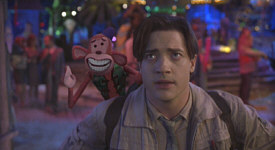 He and Julie crash, but she seems to escape largely unharmed. Stu doesn’t get off so easily, however, and he lapses into a coma. With this event, the movie splits into two storylines. The more significant of the two takes place in “Dark Town”, which seems to be a form of purgatory. There Stu hangs out with other comatose folks, and he also gets to know those who manipulate dreams. This is where we meet a version of Monkeybone who comes to life and appears to attempt to aid Stu on his quest to get back to the real world.
He and Julie crash, but she seems to escape largely unharmed. Stu doesn’t get off so easily, however, and he lapses into a coma. With this event, the movie splits into two storylines. The more significant of the two takes place in “Dark Town”, which seems to be a form of purgatory. There Stu hangs out with other comatose folks, and he also gets to know those who manipulate dreams. This is where we meet a version of Monkeybone who comes to life and appears to attempt to aid Stu on his quest to get back to the real world.
Frankly, this aspect of the story became fairly muddled at times, but all we really need to remember is that Stu’s trying to get back to his body, and they don’t want him to leave; they need creepy folks like Stu, Edgar Allan Poe, Stephen King and others to create nightmares. At the same time, Julie has to deal with Stu’s older sister Kimmy (Megan Mullaly). Allegedly she and Stu once committed each other to a pact whereby one wouldn’t let the other remain technically alive in this state; as such, she wants to pull the plug on Stu. She holds off on this due to doctor’s advice, but she remains eager to do so when a certain time period elapses.
As such, Julie has her work cut out for her. She needs to bring Stu back to life before Kimmy can end things. This makes the film a race against time for a brief period, but eventually Stu does come back to us - in a way. With the aid of sleep god Hypnos (Giancarlo Esposito) and others, Monkeybone tricks Stu, and he’s the one who leaves Dark Town. This means that the Stu we see in the latter half of the movie is actually all Monkeybone; the critter doesn’t only inhabit part of Stu’s psyche anymore.
Real Stu still attempts to get back to the world, if just for one day so he can tell Julie he loves her. Monkeybone causes mild forms of havoc; Herb loves his opportunistic ways, but Julie can tell that something’s wrong. Eventually Death (Whoopi Goldberg) agrees to let Stu return to the world briefly to set things right; he gets a loaner body before he has to come back to the dark place. Death pops Stu into the corpse of an organ donor (Chris Kattan), and a wild chase ensues.
 Since I may already have spilled too many beans, I’ll halt my synopsis there. However, it was tough to omit any of this information and still relate the story to Monkeybone. At its heart, it wasn’t a terribly complicated tale; ultimately it was simply about a guy in love who wants to make sure his girl knows how he feels. However, the film took so many strange detours, that I thought I needed to provide a somewhat more intricate discussion of the story.
Since I may already have spilled too many beans, I’ll halt my synopsis there. However, it was tough to omit any of this information and still relate the story to Monkeybone. At its heart, it wasn’t a terribly complicated tale; ultimately it was simply about a guy in love who wants to make sure his girl knows how he feels. However, the film took so many strange detours, that I thought I needed to provide a somewhat more intricate discussion of the story.
Monkeybone was the third feature film directed by Henry Selick, and all of them follow a similarly twisted path. As was the case with 1993’s The Nightmare Before Christmas and 1996’s James and the Giant Peach, in Monkeybone Selick took a fairly standard little story about a quest for love and took it on a warped journey. Of these three movies, Monkeybone featured the most significant live action aspects. Selick started as a stop-motion animator, and that was the only form of footage found during Nightmare. James included a fair amount of live action material, but the majority of the film depicted animated characters.
In contrast, live action dominated Monkeybone. To be certain, a lot of effects and forms of animation appeared during the film, but this didn’t occur to the degree seen during Selick’s past two efforts. Nonetheless, one shouldn’t expect this movie to provide radically less creative and stimulating visuals. Both Nightmare and James were praised for these aspects, and when Monkeybone stayed in the netherworld, it also showed a high level of inventiveness and excitement in this regard. At times, those scenes seemed to be a bit busy, as though Selick wanted to cram in as much as possible, but they still added life and spark to the proceedings.
As for the rest of the movie, it was a less interesting affair. On the positive side, Fraser provided a decent performance as regular Stu and as Monkeybone Stu. I’ve always liked Fraser, and I saw nothing here to alter that opinion. Fraser wasn’t as good here as he was in multiple roles for Bedazzled, but he still demonstrated his versatility and made the role better than it might have been.
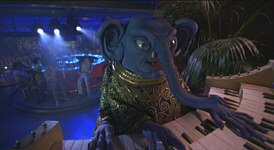 Surprisingly excellent was Kattan as “Organ Donor Stu”. Through his gig on Saturday Night Live, Kattan always seemed loose-limbed but overbearing, and his over-the-top work there usually left me cold. Although the part called for a fair amount of overacting, Kattan managed to rein in his more spastic tendencies and he provided a very creative and entertaining piece of work. The body Stu inhabits died due to a broken neck, so Kattan has to simulate a floppiness that was thoroughly convincing and amusing. He also was able to bring about the more heartfelt sequences when OD Stu met up with Julie; Kattan’s touching work made some potentially disgusting scenes seem sweet and touching.
Surprisingly excellent was Kattan as “Organ Donor Stu”. Through his gig on Saturday Night Live, Kattan always seemed loose-limbed but overbearing, and his over-the-top work there usually left me cold. Although the part called for a fair amount of overacting, Kattan managed to rein in his more spastic tendencies and he provided a very creative and entertaining piece of work. The body Stu inhabits died due to a broken neck, so Kattan has to simulate a floppiness that was thoroughly convincing and amusing. He also was able to bring about the more heartfelt sequences when OD Stu met up with Julie; Kattan’s touching work made some potentially disgusting scenes seem sweet and touching.
While Monkeybone offered some cool visuals and good performances, I ultimately thought it was a bit of a dud because it all seemed to try too hard. As I already noted, Selick packed Dark Town with an excess of elements, and the entire film suffered from that syndrome. The story was muddled and awkward, and much of it made little sense. For example, there appeared to be an ulterior motive for Kimmy’s desire to off her brother, but this area remained unexplored. The movie tossed a slew of elements at the wall but didn’t even bother to see which ones stuck; it just plopped them on the table for us to take.
During its theatrical run, Monkeybone received a critical lambasting and reached almost no audience; this $75 million project grossed a miserable $5 million in the US. On the positive side, I admired Monkeybone because it clearly attempted to do something different; for better or for worse, you don’t see many films like this. However, the execution was rather flawed, and the ultimate result was a sporadically entertaining movie that seemed like less than the sum of its parts.
The DVD:
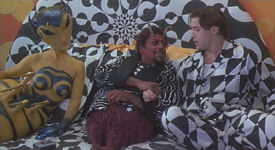 Monkeybone appears in an aspect ratio of approximately 1.85:1 on this single-sided, dual-layered DVD; the image has been enhanced for 16X9 televisions. For the most part, the picture looked good, but a few modest concerns kept it from a level of excellence.
Monkeybone appears in an aspect ratio of approximately 1.85:1 on this single-sided, dual-layered DVD; the image has been enhanced for 16X9 televisions. For the most part, the picture looked good, but a few modest concerns kept it from a level of excellence.
Overall, sharpness seemed to be nicely crisp and detailed. However, softness occasionally interfered. These problems mainly appeared during wide shots, but some interiors - particularly those that involved Julie and Kimmy at the hospital - showed additional fuzziness. Neither moiré effects nor jagged edges caused any problems, and print flaws were very modest. I witnessed a few speckles, and some grain and grit appeared during a dream sequence, but as a whole, the movie looked clean.
I don’t suppose it really qualifies as a “print flaw”, but I need to note that Monkeybone provided some of the worst composite work I’ve seen. Most of the film’s visual effects looked quite good, as the vast majority of them blended well with the action. However, during the movie’s climax, Kattan and Fraser performed some greenscreen work, and these shots appeared atrocious. I haven’t seen such fake-looking material in years, and the quality was especially bad considering the high caliber of the rest of the shots. How those images got past quality control is a mystery to me, but they genuinely appear terrible. The shots also displayed some moderate grain and other small defects that made it work less well.
Colors often seemed to be nicely rich and vivid. The Dark Town scenes offered the strongest hues. Those portions of the film featured a very varied palette, and the DVD replicated the bright neon tones with fine accuracy and vibrancy. However, shots back in the “real world” occasionally appeared a bit flat. Skin tones could seem a bit drab and muddled at times, especially when Stu was in his coma.
 Actually, those scenes consistently provided the DVD’s most significant concerns, and the issue of contrast displayed the greatest problems. Black levels generally appeared to be deep and dense, but shadow detail occasionally became awfully heavy. These problems manifested themselves most during those shots that took place in the hospital. While I didn’t expect these to be bright and sunny, they looked ridiculously. When Dr. Edelstein entered the room, his face appeared virtually invisible. Though these segments didn’t comprise a majority of the film, they bothered me to a degree that they disrupted my enjoyment of the visuals. As such, though much of Monkeybone looked very good, the poor shots dragged it down to an overall “B’ grade.
Actually, those scenes consistently provided the DVD’s most significant concerns, and the issue of contrast displayed the greatest problems. Black levels generally appeared to be deep and dense, but shadow detail occasionally became awfully heavy. These problems manifested themselves most during those shots that took place in the hospital. While I didn’t expect these to be bright and sunny, they looked ridiculously. When Dr. Edelstein entered the room, his face appeared virtually invisible. Though these segments didn’t comprise a majority of the film, they bothered me to a degree that they disrupted my enjoyment of the visuals. As such, though much of Monkeybone looked very good, the poor shots dragged it down to an overall “B’ grade.
Much more consistently satisfying were the soundtracks of Monkeybone. Yes, this was another of those DVDs that included both Dolby Digital 5.1 and DTS 5.1 mixes, and as so often seems to be the case these days, I discerned virtually no difference between the two. That was a good thing, as Monkeybone provided a rather rich and satisfying auditory experience.
The soundfield seemed to be nicely broad and well-defined. Throughout the film, music displayed fine stereo separation, and the score also spread effectively to the rear channels; these elements played clearly through all of the speakers, which added a nice spark to the mix. Effects were very neatly delineated and accurately placed within the environment. The forward spectrum showed clean spacing between effects and they blended together well; the entire track panned in a natural manner, as can be observed through scenes like one in which a golf club was swung.
Surround usage appeared to be active and compelling. This movie offered a lot of good opportunities for the track to become involving, and the mix took advantage of these chances. All in all, the film provided a very well-defined and engrossing soundfield.
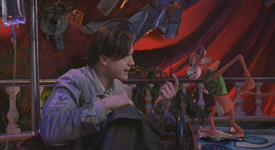 Audio quality also seemed to be strong. Though much of the speech must have been dubbed, dialogue always appeared to be crisp and distinct, with no signs of edginess or problems related to intelligibility. Effects were robust and accurate, and they showed no distortion or other concerns. The score was bright and dynamic, and the entire track showed solid range. Highs appeared to be clean and clear, while low end came across as rich and deep. Ultimately, I thought Monkeybone offered a very nice soundtrack that worked well for the material.
Audio quality also seemed to be strong. Though much of the speech must have been dubbed, dialogue always appeared to be crisp and distinct, with no signs of edginess or problems related to intelligibility. Effects were robust and accurate, and they showed no distortion or other concerns. The score was bright and dynamic, and the entire track showed solid range. Highs appeared to be clean and clear, while low end came across as rich and deep. Ultimately, I thought Monkeybone offered a very nice soundtrack that worked well for the material.
As a special edition, we’d expect Monkeybone to include a nice mix of extras, and it does. First up is an audio commentary from director Henry Selick. Although his track for the special edition of The Nightmare Before Christmas tended to be somewhat dry and technical, he provided a nicely entertaining and compelling piece here. Selick realized that he’d go over technical information during the “Monkeybone Secrets Revealed” section, and that clearly freed him to cover different ground during the main commentary.
Selick remains a fairly low-key speaker, but he seemed to be honest and forthcoming about the movie. He discussed aspects of the film he’d like to change, and he remarked upon a wide variety of changes made to the flick due to studio and producer pressure. Although he didn’t get into hairy details, Selick clearly related his lack of agreement with producer Chris Columbus, though I don’t suppose it should surprise anyone that Selick and the man behind Home Alone would fail to see eye-to-eye.
In addition, Selick went over the ways the actors worked with the roles, the manner in which the project developed, origins of the piece, and a slew of additional topics. At times the pace can slow, but as a whole, I thought Selick added a very interesting and useful commentary that I genuinely enjoyed.
 Next we find a collection of Extended Scenes. There are 11 in all, and they run between 28 seconds and four minutes and 43 seconds for a total of 21 minutes, 52 seconds of footage. Most of the clips seemed to be generally interesting but unspectacular. However, a few of them were more worthwhile, especially one in which we see a longer version of Stu’s accident. During this piece, we discover why Julie escaped unscathed.
Next we find a collection of Extended Scenes. There are 11 in all, and they run between 28 seconds and four minutes and 43 seconds for a total of 21 minutes, 52 seconds of footage. Most of the clips seemed to be generally interesting but unspectacular. However, a few of them were more worthwhile, especially one in which we see a longer version of Stu’s accident. During this piece, we discover why Julie escaped unscathed.
The clips are available with or without commentary from director Henry Selick. He adds very little to the proceedings, as he’s radically less chatty than he was during the overall commentary. He speaks only sporadically, and though he provides basic information about why the snippets were deleted, he didn’t contribute a lot to the piece. To save time, don’t bother to watch the scenes on their own and then with commentary; just check them out with Selick’s remarks, as he speaks on top of so little of the material that you’ll easily be able to make out the action.
Note that if you select the “Play All” option, a very brief graphic appears. As far as I can tell, you can’t access this unless you go through “Play All”. It’s not much of an image, but I thought I’d mention it anyway.
Note also that although the DVD’s case lists both “11 extended scenes” and an alternate ending, the latter is actually one of the former. The different conclusion exists as the last of the elongated sequences and doesn’t appear on its own. Fox seem to have a lot of trouble with their DVD cases, as they often provide incorrect data; this one also relates that the movie runs for 100 minutes, whereas it’s actually about 93 minutes in length.
More video pieces appear in Monkeybone Secrets Revealed. This section includes seven different segments that show shots at various levels of completion; we see lots of raw examples of effects material. These snippets run between 61 seconds and four minutes, three seconds for a total of 16 minutes and 24 seconds of footage. Although these pieces can become somewhat redundant, I still thought they were a lot of fun. It’s interesting to see how the components mix together and how they were created. This piece also includes some bits that didn’t make the final film, such as Monkeybone’s quick Bill Clinton impression.
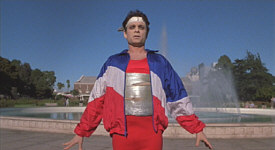 As with the “Deleted Scenes”, this area can be viewed with or without commentary from Selick. I also felt that the segments didn’t need to be watched without Selick’s remarks, but for a different reason. He offers a lot more information here, but since the vast majority of the clips can be found in the movie proper, there was no real reason to check them out on their own.
As with the “Deleted Scenes”, this area can be viewed with or without commentary from Selick. I also felt that the segments didn’t need to be watched without Selick’s remarks, but for a different reason. He offers a lot more information here, but since the vast majority of the clips can be found in the movie proper, there was no real reason to check them out on their own.
In any case, Selick adds a fair amount of decent details as he relates technical notes about the effects. His comments made the work more comprehensible and compelling. Note that he only speaks during a little more than the first half of the program. Selick departs during the third segment, which means that he leaves after the first nine minutes and 42 seconds of footage when viewed through the “Play All” option.
The next area provides a substantial Monkeybone Gallery. This area’s split into five different subjects; we find “Monkeybone”, “Downtown”, “Coma Bar”, “Hypnos”, and “Land of Death”. Within each of these, we discover between four and eight subareas that add up to 29 of these. The subsections provide between two and 50 images for a total of 280 stills in all. Though the presentation makes them a bit awkward to access - you’ll frequently return to the prior menu - the information was quite good, as I found a nice mix of art design and other elements.
The “Monkeybone Gallery” also provided some video snippets. On eight occasions, you’ll be allowed to play a short clip of the work on different costumes. Four of these crop up in “Downtown” (“Pig Chef”, “Betty Bovine”, “Cyclops” and “Centaur”), while two are in “Coma Bar” (“Bull” and “Elephant”) and two appear in “Hypnos” (“Medusa” and “Hypnos”). The snippets run between five and 15 seconds, and while they’re obviously quite brief, they’re still moderately interesting.
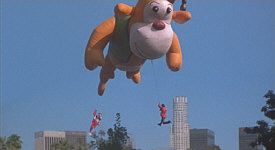 Lastly, Monkeybone includes the film’s theatrical trailer and three TV spots. Interestingly, the trailer depicts the extended version of Stu’s injury; we see the extra parts that didn’t make the movie.
Lastly, Monkeybone includes the film’s theatrical trailer and three TV spots. Interestingly, the trailer depicts the extended version of Stu’s injury; we see the extra parts that didn’t make the movie.
Ultimately, I thought that Monkeybone was an interesting experiment but not a terribly successful one. While it provided sumptuous and inventive visuals and some solid acting, the story itself was drab and thin, and the movie’s attempts at humor often fell flat. The DVD offered erratic but largely fine picture with a terrific soundtrack and a nice little roster of extras. Fans of unusual and dark comedy fantasies should probably give Monkeybone a look, but this film will not work for a wide audience; for better or for worse, it’s just too odd to maintain mass appeal.